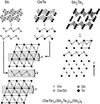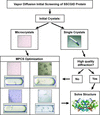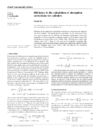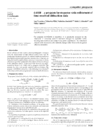issue contents
October 2010 issue

Cover illustration: PDB_REDO optimization of the oldest structure with experimental data in the PDB [155c; Timkovich & Dickerson (1976). J. Biol. Chem. 251, 4033-4046]. Front: final structure - warmer colours show greater atomic displacement. Back: final structure model with atomic trajectories in yellow. Courtesy of Joosten et al. [J. Appl. Cryst. (2009), 42, 376-384].
research papers
Dynamical scaling properties in fractal structures were investigated from small-angle X-ray scattering data of the kinetics of aggregation in silica-based gelling systems at different temperatures. The experimental findings are in notable agreement with the dynamical scaling properties.
Conoscopic patterns in a system of two crystal plates where the optical sign of one plate is known make it possible to identify the sense of the other crystal plate. The unknown optical sign of the crystal plate is determined by the nature of changes made to its conoscopic pattern by the plate of known optical sign.
The effect of the addition of polyethylene glycol (PEG) on the structure of a water-based ferrofluid (magnetite coated with sodium oleate) is followed using contrast variation in small-angle neutron scattering. A significant change in the complex aggregates, as a result of PEG adsorption by magnetite, is revealed.
Short-time diffusion in charge-stabilized colloidal dispersions is studied by theory, simulation and scattering experiments. Generic features in self-diffusion, cage diffusion and sedimentation are explored.
The reflection-order-dependent increase of the integral breadth of microstrain broadening on the d* scale is investigated. Whereas for negligible local strain gradients `usual', linear increase of the integral breadth occurs, strain gradients can lead to a nonlinear and, for the special case of uncorrelated strains, to a parabolic increase of the integral breadth in association with Lorentzian line shapes.
La2O3 and P2O5 powders are directly used as precursors for preparing monazite-type LaPO4 nanomaterials via an additive-free oxides–hydrothermal method. Many factors can affect the morphology and structure of the products, but the P/La molar ratio cannot change the composition in the given synthesis system.
Evaluation of the small-angle X-ray scattering of two-phase systems allows the determination of a measure of the polydispersity of the chord lengths within the dilute phase, which depends on the size distribution and the shape of the particles forming this phase.
The aggregation kinetics of solutions of vinyltriethoxysilane-derived organic/silica species were studied by small-angle X-ray scattering (SAXS) in a strongly basic medium. The SAXS intensity was analysed using a modified Sharp–Bloomfield global function and its evolution was found to be compatible with the growth, coiling and branching of the polymeric macromolecules in solution.
Download citation


Download citation


Ambiguities in the interpretation of diffraction data from layered chalcogenides arise from almost homometric non-congruent structure models, especially if mixed site occupancies are present. Further pitfalls can result from stacking disorder of distinct tetradymite and A7-type building units.
Using a desiccant as a substitute for a reservoir solution in the vapor diffusion technique was found to remarkably increase the success rate of crystallization, showing that it could be utilized in practical protein crystallization to yield more crystallization conditions.
An analytical expression approximating the diffraction peak profile produced by spherical crystallites with a lognormal size distribution is presented. The approximation conserves the volume- and area-averaged column lengths of the exact profile, being appropriate for implementation in the whole powder pattern fitting programs.
Download citation


Download citation


A disorder–order phase transition in pyridinium-3-carboxylic acid perchlorate was studied by differential scanning calorimetry, dielectric measurement and variable-temperature X-ray single-crystal diffraction analysis.
The nucleation of dislocations at controlled indents in silicon during rapid thermal annealing has been studied by in situ X-ray diffraction imaging (topography).
Identification of single photoswitchable molecules in an amorphous xerogel matrix is demonstrated using neutron powder diffraction and the Debye approach.
The strain profiles in ion-implanted single crystals are determined using high-resolution X-ray diffraction and the generalized simulated annealing algorithm.
In situ monitoring of the recrystallization of Cu–In–S thin films by means of X-ray diffraction reveals that the process is composed of three steps: consumption of the CuIn5S8 phase, growth of CuInS2 grains, and a transition from the Cu–Au-type to the chalcopyrite-type ordering of CuInS2.
Variable-temperature X-ray diffraction data from the α(1 0 11), α(200), α(2 0 10), β(3 11 1) and β(2 21 1) lattice planes of one-dimensional Ta2O5 nanorods reveal complex and polymorphic thermochromic phase transformations, which incorporate β to α (β–α), β to β (β–β), α to α (α–α) and α to β (α–β) phase transitions at elevated temperatures ranging from 300 to 750 K.
Open  access
access
 access
accessThis paper describes the design, construction and initial operation of the extended Q-range SANS instrument at the Spallation Neutron Source (SNS). It also introduces a novel frame-skipping mode of operation on the instrument.
Open  access
access
 access
accessThe Microcapillary Protein Crystallization System (MPCS) is used to successfully optimize protein crystals from 28 out of 29 tested proteins. Six protein structures have been determined from diffraction-ready crystals grown inside and harvested directly from the MPCS CrystalCards, which are compatible with the recently commercialized and automated MPCS Plug Maker instrument.
A full analytical model for analysing small-angle neutron scattering data from polymer-modified liposomes is derived. It is demonstrated that the model provides a more accurate structural description of the experimental data than conventional centrosymmetric shell models.
Download citation


Download citation


This paper highlights the importance of thoroughly characterizing commercial products by complementary methods. The presence of impurities in such products could become a non-negligible parameter for physical and chemical properties studies.
The implementation of hydrogen treatment functionality in the software suite CRYSTALS is described.
Al–3.31wt% Fe was solidified to form the primary Al3Fe phase. The crystallographic features (the extension directions, the complete twinning elements and the surface planes binding the primary phase in the extension directions) of the primary phase were investigated experimentally by electron backscatter diffraction.
cryocrystallography papers
A new Peltier cooling device has allowed the collection of neutron diffraction data from temperature-sensitive crystals of inorganic pyrophosphatase.
short communications
An alternative method for determining the structure factor of a Bragg reflection is described. It is shown that, for broad reflections, the structure factor can be obtained from linear scans through the reflection in reciprocal space, and the necessary correction factors and diffractometer slit settings are pointed out.
Efficiency in the calculation of absorption corrections for cylinders has been examined. Application of the Gauss–Legendre quadrature to the formula proposed by Thorkildsen and Larsen gives results having a relative error ≤10−6 with 12 × 12 terms in the numerical integrals.
computer programs
Fityk is portable, open-source, graphical software for nonlinear curve fitting, with an add-on for Pawley refinement of powder patterns.
The program LASER for refinement of time-resolved X-ray diffraction data uses the externally-induced intensity changes, rather than the individual intensities, as the data to be refined.
laboratory notes
A laboratory apparatus is presented that delivers an X-ray microbeam to perform simultaneous X-ray fluorescence and diffraction measurements. The instrument combines specific detectors and optics to optimize performance.
crystallographers
Free 



 journal menu
journal menu


















































